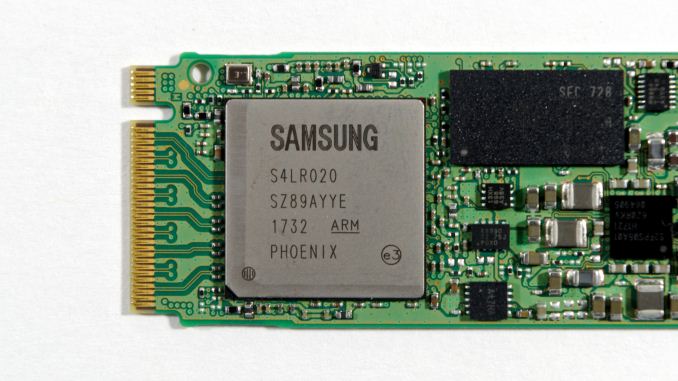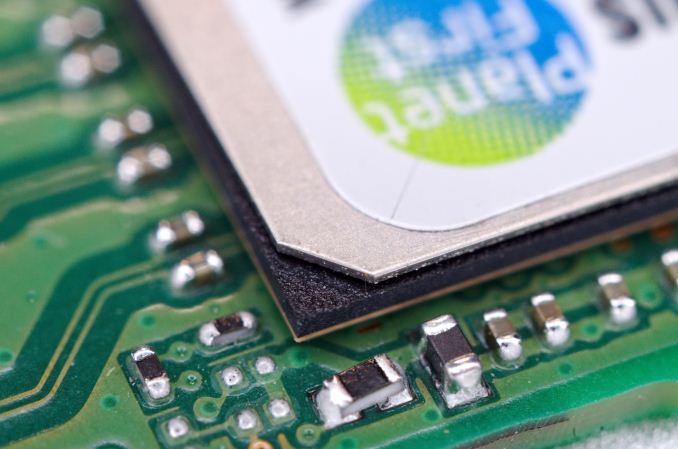The Samsung PM981 SSD Review (512GB, 1TB): Next Generation Controller And 3D NAND
by Billy Tallis on November 30, 2017 9:02 AM EST
Samsung's retail NVMe SSDs, like the 960 PRO, are well-known as some of the fastest SSDs for consumers, but the release of these consumer drives is usually preceded by OEM drives based on similar technology. For example, the 960 Pro is almost identical to the SM961, and the 950 Pro is based on the same controller found in the SM951. The 971 client series was for BGA SSDs, so for the next generation consumer drives, Samsung is expected to use the PM981 controller and NAND as a base for the design. Luckily, the PM981 is the subject of this review.
The Samsung PM981 is Samsung's fourth-generation client PCIe SSD, based on the Phoenix controller and 64-layer V-NAND - both of which have yet to show up in Samsung's retail NVMe SSDs. The PM981 offers both a preview of Samsung's next generation retail NVMe SSDs, and a look at what will likely be the fastest storage available in a high-end notebook computer for the next year.
The Samsung Phoenix NVMe controller has been making appearances at trade shows all year, mostly in the new hot-swappable enterprise form factor PM983 enterprise SSD that Samsung has been promoting for high density solid state storage. Little has been disclosed about this controller other than its name, Phoenix, but it seems to be an incremental evolution of Samsung's client and low-end enterprise SSD controller architecture. With roughly the same package size as the previous generation Samsung Polaris controller, the Phoenix likely retains the same basic configuration of PCIe lanes and NAND and DRAM channels. When Samsung announces retail products based on this controller we should be able to get some information about what's changed internally to allow for improved performance, but for now, even with our testing, we can only speculate. It is clear that Samsung is taking cooling more seriously this time around with a metal heatspreader on top of the package, similar to what i's used on the Silicon Motion SM2260 controller. Samsung has previously used copper foil in the drive stickers to help dissipate heat, so this marks a step up in attempting to cool the controller. Other M.2 PCIe SSD vendors have used that tactic and many have also released drives with more substantial heatspreaders or heatsinks in the future.
The 64-layer 3D TLC NAND Samsung uses in the PM981 has been gradually rolling out across their product lines this year, starting with the Portable SSD T5. Earlier this week we took a look at the Samsung SSD 850 120GB, a new model SATA drive that has been released in the Asian market. The SSD 850 also incorporates the 64-layer 3D TLC, but the small drive capacity and SATA interface were both limiting the extent to which we could measure the performance improvements the new NAND enables.

256GB Package with 8 dies of 64L TLC V-NAND
With a per-die capacity of 256Gb (32GB), it is not that much of a challenge for Samsung to make the 1TB PM981 a single-sided drive by stacking each of the packages with 16 NAND chips each. The 512GB model uses 8-high stacks and is about 0.4mm thinner as a result. The model number stenciled in the circuit board indicates that Samsung does not plan to use this layout for anything larger than 1TB, so if a 2TB model shows up it will probably use a denser layout of four packages rather than switch to 512Gb NAND dies.
| Samsung OEM Client PCIe SSD History | ||||
| Controller | NAND Flash | Notes | Consumer Variant |
|
| XP941 | S4LN053X01 | 2D MLC | PCIe 2.0, AHCI | - |
| SM951 | UBX | 2D MLC | AHCI or NVMe | 950 PRO |
| PM951 | 2D TLC | - | ||
| SM961 | Polaris | 2D & 3D MLC | 960 PRO | |
| PM961 | 3D TLC | 960 EVO | ||
| PM971 | Photon | 3D TLC | BGA SSD, PCIe 3 x2 | - |
| PM981 | Phoenix | 3D TLC | 980 Evo? | |
Samsung's OEM client PCIe SSDs are usually not an exact match for the retail products of the same generation. Their first-generation XP941 used a PCIe 2.0 interface with AHCI instead of NVMe, and never got a retail counterpart. The SM951 and PM951 used planar MLC and TLC respectively, while the later 950 PRO used Samsung's 3D MLC NAND. The SM961 also seems to use planar MLC for its smaller capacities, though the TLC-based PM961 is entirely based on 3D NAND. The Samsung PM971 is an entry-level BGA SSD that may not get a retail counterpart, and if it does it will not fit into either of the existing 9x0 PRO/EVO product tiers.
Based on the model number, the PM981 could be expected to serve as a preview of a 980 EVO product. However, every SSD Samsung has moved to 64-layer V-NAND has used TLC—even the high-end enterprise SSDs. With Samsung's Z-NAND covering the high-performance low-latency niche, Samsung may retire the use of MLC NAND from their more mainstream product lines. If Samsung is not planning to release an enthusiast-oriented Z-NAND product, then the PM981's retail counterpart may have to serve as successor to both the 960 EVO and 960 PRO.
For this review, the primary comparisons will be against the Samsung 960 PRO and 960 EVO, the closest retail equivalents to Samsung's previous generation of client PCIe SSDs. Results for many other PCIe SSDs and a few SATA SSDs are included for comparison. Power measurements are still missing due to a recent equipment failure, but new and much better SSD power measurement equipment is on the way.
| AnandTech 2017 SSD Testbed | |
| CPU | Intel Xeon E3 1240 v5 |
| Motherboard | ASRock Fatal1ty E3V5 Performance Gaming/OC |
| Chipset | Intel C232 |
| Memory | 4x 8GB G.SKILL Ripjaws DDR4-2400 CL15 |
| Graphics | AMD Radeon HD 5450, 1920x1200@60Hz |
| Software | Windows 10 x64, version 1703 |
| Linux kernel version 4.12, fio version 2.21 | |
- Thanks to Intel for the Xeon E3 1240 v5 CPU
- Thanks to ASRock for the E3V5 Performance Gaming/OC
- Thanks to G.SKILL for the Ripjaws DDR4-2400 RAM
- Thanks to Corsair for the RM750 power supply, Carbide 200R case, and Hydro H60 CPU cooler

















53 Comments
View All Comments
romrunning - Thursday, November 30, 2017 - link
@sleeplessclassics - "Today, even TLC can perform better than MLC/SLC just 2-3 generations ago due to better controllers."Well, the MLC-based 950/960 Pro still is basically beating all of the newer TLC drives. Even in SATA, my Sandisk Extreme Pro still beats all of the TLC drives.
sleeplessclassics - Friday, December 1, 2017 - link
@romrunning, well you should have paid more attention in your high school English class.I am comparing present-gen TLC NAND with SLC/MLC that is two generations old.
Of course, current gen 950/960 Pro MLC NAND with Polaris controllers will beat TLC NAND with Polaris controllers.
I suggest you begin one of the simpler ones like Aesop's fables or maybe those illustrated children books will more your level. And while you are at it, try getting an IQ test as well
romrunning - Friday, December 1, 2017 - link
You mad, bro?! ;)Lighten up a little, and act a little more objectively. Try clarifying the original statement or submitting more information to support your point without resorting to childish insults.
For example, I will submit that you would have had to define "generations" and product lines before you put out generic statements like "Today, even TLC can perform better than MLC/SLC just 2-3 generations ago due to better controllers.". It's also hard to compare since the interface can change (like from SATA to NVMe).
For my example, I will say again that my SATA Sandisk Extreme Pro will still beat newer TLC-based SATA drives from Sandisk. Also, I believe older Intel enterprise controllers (like a DC P3700) can still beat a terrible newer drive like the Intel 600p. There are even specialized drives from several "generations" of product lines ago that can beat some of the "newer" TLC-based drives in the same product line-up.
However, obviously this is changing with NVMe-based drives, although it would harder to find a mfg with two "generations" of controllers on NVMe drives. Plus, we're getting into different tech like 3d XPoint, so TLC likely won't be around anymore a number of years in the future.
I personally am looking forward to retail releases of Samsung's Z-NAND-based drives. It will be very interesting to see how they measure up performance-wise to Optane.
treecrab - Thursday, November 30, 2017 - link
Sequential write numbers are off.1TB drive has fooled you - it has HUGE write buffer. Like 50GB huge. You need to check write speed second by second and on a much larger span (100 GB?)
mapesdhs - Thursday, November 30, 2017 - link
Toms posted a review and pointed this out with their sustained tests.Drumsticks - Thursday, November 30, 2017 - link
It feels like we haven't seen new high end drives from Samsung in a while (not that they're really heavily in need given the performance on tap already). It'll be nice to see another round of products coming out of them. Thanks for the review!Side note: Would it be possible to, in future SSD reviews, add those buttons that change the graphs based on capacity for the different storage metrics? Perhaps a button for "All SSDs," "250GB," "500GB," "1TB+" or something. Performance can vary wildly across capacities, and it would be a nice way to sort through all of the 500GB class drives that you've reviewed for example. The only outlier would be Optane since it isn't quite as dominated by the amount of parallel dies you can add.
mapesdhs - Thursday, November 30, 2017 - link
Good idea; it's bizarre how sometimes the 960 EVO looks terrible compared to the 1TB version, and sometimes the other way round. Steady state is particularly bad, it's why I stuck with hunting for 950 Pros instead, which also have their own boot ROM and thus work ok on older mbds.Kastriot - Thursday, November 30, 2017 - link
200$ for 512GB i have intel 530 480GB which i bought on ebay for 80 euros 3 years ago and still working great so ssd prices are insane like memory+gpu+intel cpu-s prices together, dark times for PC desktop owners unless you have dosh :)mapesdhs - Thursday, November 30, 2017 - link
GN has commented on this quite a lot recently, it is indeed a sucky time to build a new PC. Hence why I make the most of used parts (or new ones via normal auction) until the need for something better really is paramount. Bagged another 840 Pro 256GB recently for a good price; pity old models like this are not included in newer product reviews, I bet they'd put newer products to shame. For a while the old Vector was retained in newer reviews, but then it vanished, probably because it just looked too good compared to the latest tech. The same likely applies to the Neutron GTX, Vertex4 and various other models, at least in the SATA world anyway. If one can though, it's better to go NVMe, the SM951 and SM961 are rather good.bcronce - Thursday, November 30, 2017 - link
It looked mostly on par until the "mixed" results. Nice!